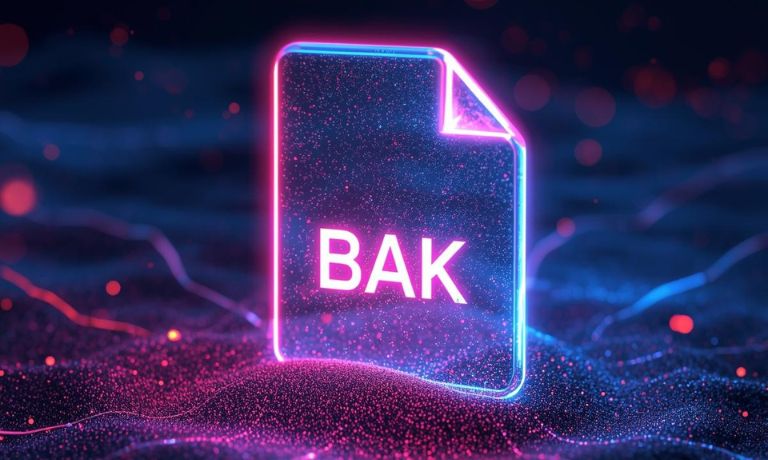You might come across a strange file ending with .bak on your computer and wonder what it is. It may look confusing, but don’t worry, it’s not a virus or something dangerous. A BAK file is simply a backup copy made by a program to protect your data.
These files are created automatically or manually by software to save another version of your work. You’ll find them in folders from programs like Microsoft Office, AutoCAD, or even your web browser.
What Is a BAK File?

A BAK file (short for backup) is a file that stores a copy of data from another file. It acts as a safety net in case something goes wrong with the original version.
For example, when you edit a file or install an update, the program may make a backup and name it document.txt.bak. If your original file becomes corrupted or deleted, the BAK file can restore it.
It’s a general file type, meaning many programs use it, not just one specific app.
Why BAK Files Exist
Programs create BAK files to protect your work from loss or damage. This process often happens automatically in the background.
Common reasons include:
- The software saves a copy before overwriting your file.
- You make a manual backup before editing something important.
- The system creates backups during updates or migrations.
They’re built for data safety, not for direct use. Think of them as emergency copies.
Programs That Create BAK Files
Different software tools use BAK files for their own purposes. Here are a few examples:
- Microsoft SQL Server – uses
.bakfiles to store database backups. - AutoCAD – saves a
.bakversion of your drawing (.dwg) automatically. - Mozilla Firefox – creates
.bakfiles for profile data or bookmarks. - Microsoft Word and Excel – generate temporary
.bakcopies during autosave.
The file content depends on the program that made it. That’s why one BAK file might open as text, and another might hold complex database data.
How to Open a BAK File
There’s no single program that opens every BAK file. How you open it depends on where it came from.
Here are a few safe ways to try:
- Rename it to the original file extension.
Example: photo.jpg.bak → photo.jpg. - Open with a text editor if you think it’s a document or configuration file.
- Use the software that created it.
- SQL Server users can restore it using the “Restore Database” feature.
- AutoCAD users can rename
.bakto.dwgto recover a drawing.
If none of these work, don’t delete it yet, you might need it later to restore data.
How to Restore Data from a BAK File
Restoring a file is usually easy once you know which program made the backup.
Steps:
- Open the program linked to the BAK file.
- Find its “Restore,” “Import,” or “Recover” option.
- Select the BAK file from your computer.
- Confirm and wait for the process to finish.
For example, in SQL Server, you go to the Restore Database and pick your .bak file. In AutoCAD, just rename the .bak file extension back to .dwg and open it normally.
Can You Convert or Rename a BAK File?
Yes sometimes. If you’re sure what the original file type was, you can rename it by changing “.bak” to the correct extension.
Example:
- report.doc.bak → report.doc
- project.dwg.bak → project.dwg
However, don’t rename files from large programs like databases unless you’re sure it’s safe. Instead, use the software’s restore option to avoid damaging the file.
Is It Safe to Delete BAK Files?
Usually, yes, but only if you’re sure the data is backed up elsewhere. BAK files are only needed for recovery. If your system or app is working fine and you have no need to restore anything, deleting old BAK files can free up space.
Just be careful not to remove recent backups from important programs like SQL Server or design software.
Common Problems with BAK Files
Some people face issues like:
- File won’t open: You’re using the wrong program. Try the original software.
- Corrupted backup: The file was saved during a crash or failed update.
- Unknown file type: You don’t know what created it. Use a text editor to check clues in the content.
If nothing works, use a file repair or recovery tool or contact technical support for that software.
Best Practices for Managing BAK Files
A few easy habits can help keep your backups organized and safe:
- Save backups in clearly labeled folders.
- Keep only recent copies; delete old ones occasionally.
- Store important backups in cloud drives or external disks.
- Never open or edit BAK files from unknown sources, as they could contain harmful scripts.
These steps make sure your backups stay useful when you actually need them.
Conclusion: Backup Files That Protect Your Data
A BAK file is nothing to fear; it’s a small safety feature built into many programs to protect your data. Whether it’s a document, drawing, or database, the BAK file is a backup that can save you when something goes wrong.
If you find one on your computer, treat it as a helpful safety net. Knowing what it is, how to open it, and when to delete it keeps your files organized and your data safe.
I’ve been into SEO and blogging for over 7 years. I help websites show up higher on search engines. I really enjoy writing helpful guides, especially about gaming and tech stuff.
